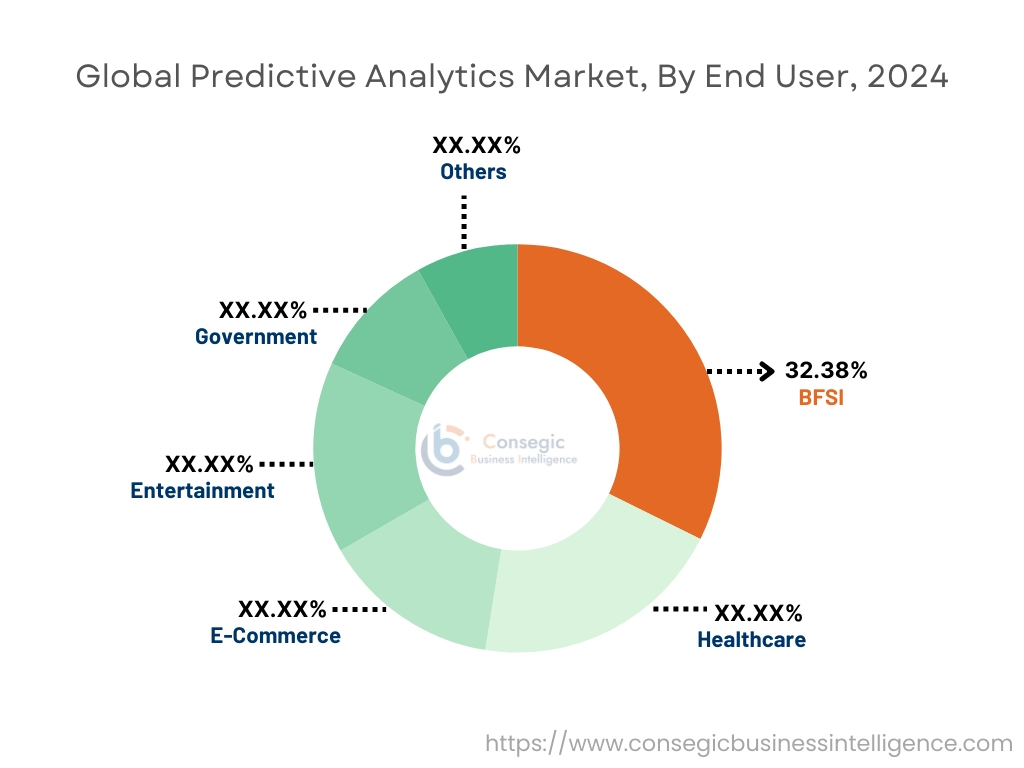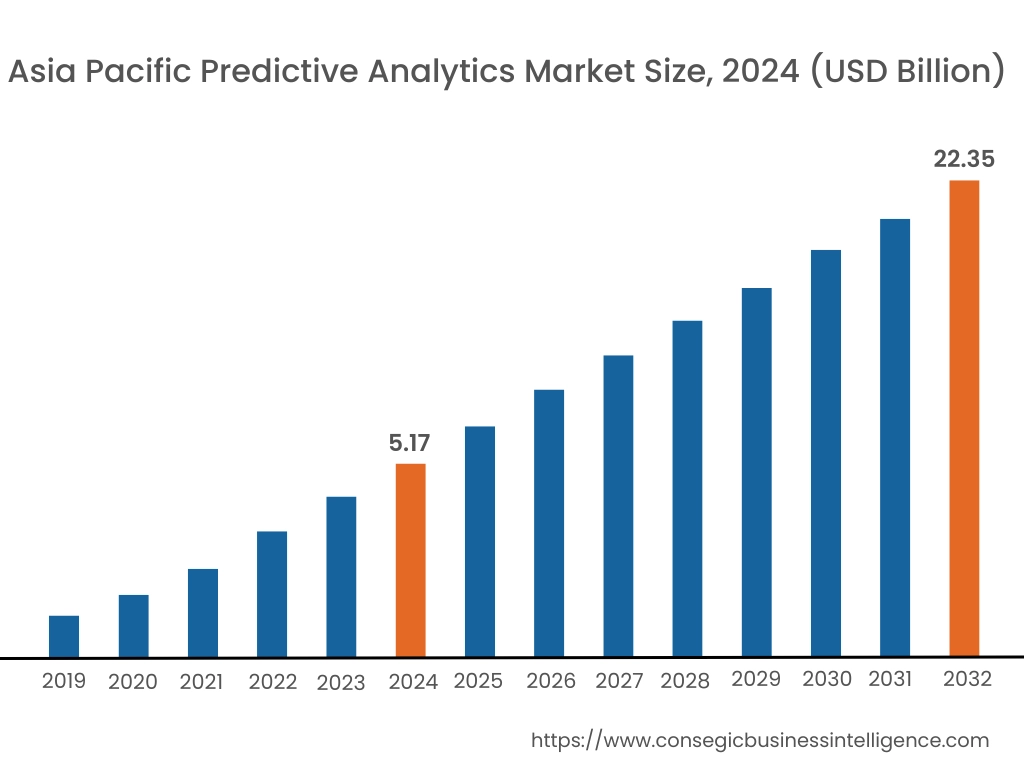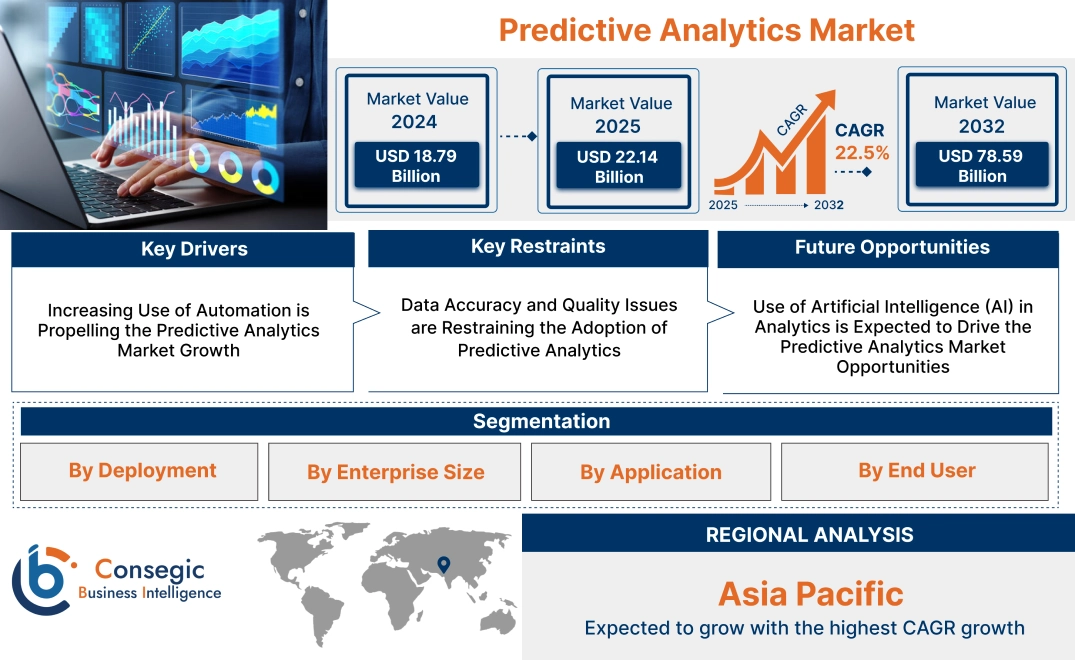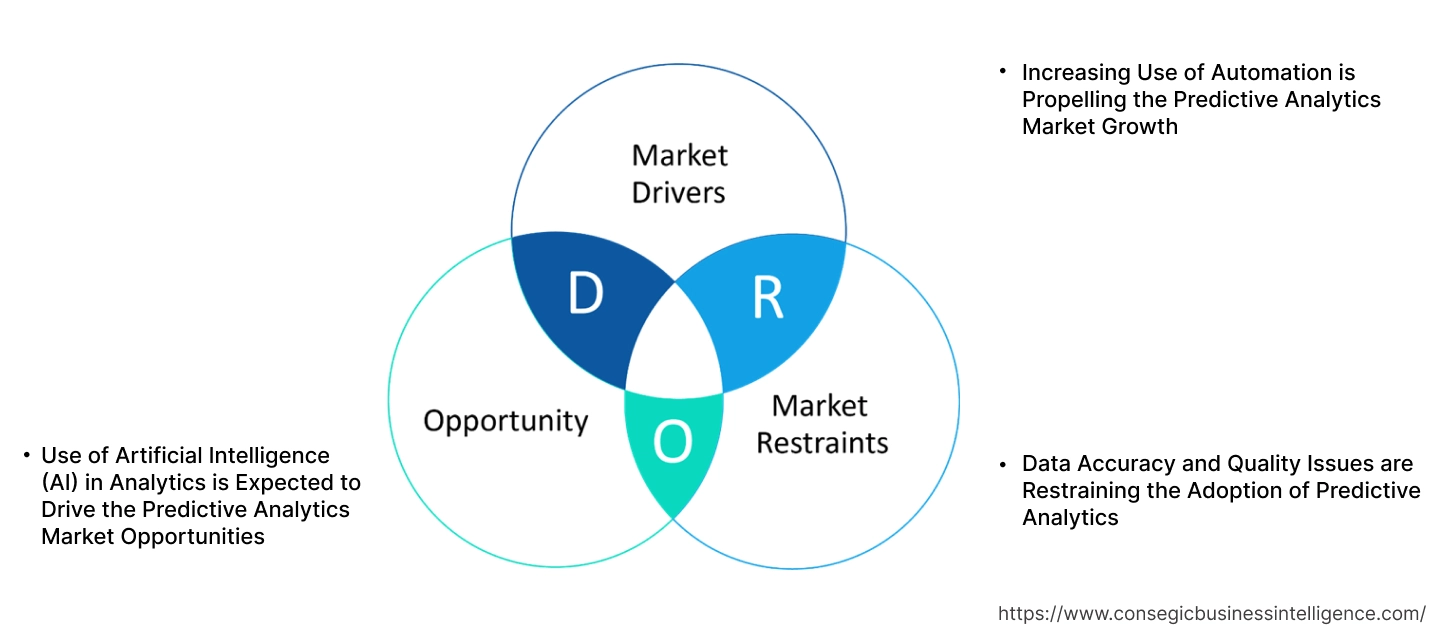- Summary
- Table Of Content
- Methodology
Predictive Analytics Market Size:
Predictive Analytics Market size is estimated to reach over USD 78.59 Billion by 2032 from a value of USD 18.79 Billion in 2024 and is projected to grow by USD 22.14 Billion in 2025, growing at a CAGR of 22.5% from 2025 to 2032.
Predictive Analytics Market Scope & Overview:
Predictive analytics refers to the process of using data and performing data analysis to predict future outcomes and trends. It encompasses a variety of statistical techniques such as machine learning which is used to analyze current developments accurately and predict future outcomes. Predictive analytic tools have experienced significant growth due to the increasing need for businesses to derive meaningful insights from data especially big data. Further, optimization of operations, reducing risks, forecast revenue, and quality & production failure prediction have resulted in the growth of predictive analytics market trends.
Key Drivers:
Increasing Use of Automation is Propelling the Predictive Analytics Market Growth
Analytics tools used by businesses for prediction have experienced technological advancements in the overall analysis procedure using automated workflows. Many analytics tools today use automated workflows that simplify the data handling and model building process. Software tools have started integrating automated workflows to handle tasks like data cleaning, feature engineering, model building and deployment with minimal or no human intervention.
- For instance, SAP offers SAP Predictive Analytic which is a tool that combines statistical analysis and data mining to help users build predictive models. It allows for the discovery of data insights and the forecasting of future events. SAP also offers Predictive Factory that lets the user automate the management of predictive models making it easier to apply a model to a new data set.
Hence, the increasing use of automation in analytics software used for prediction is driving the market.
Key Restraints:
Data Accuracy and Quality Issues are Restraining the Adoption of Predictive Analytics
Data accuracy and quality issues often arise when the data is being collected from different channels. The data collection process may fall short of providing accurate data as data can often be incomplete or filled with improper values, which affects the predictive analytics market demand. Moreover, prediction of future outcomes can only be done accurately when the data is accurate, complete and relevant. Further, when data is inaccurate, incomplete and irrelevant, the predictive models can give incorrect predictions. Thus, as per the predictive analytics market analysis, the concerns arising due to data accuracy and quality act as a restraint to the predictive analytics market demand.
Future Opportunities :
Use of Artificial Intelligence (AI) in Analytics is Expected to Drive the Predictive Analytics Market Opportunities
Many companies today are deploying AI and ML algorithms for accurate data analysis and forecasting making the overall process easier and more accurate. AI techniques like Natural Language Processing (NLP) can help make meaningful insights from large amounts of unstructured data. NLP can also be used to extract useful information from large volumes of textual data by analyzing the words used in the data. Further, large volumes of text can be analyzed and processed into specific words and phrases for data cleaning, forecasting, and other analytical purposes. Thus, rising technological advancements in AI are projected to drive predictive analytics market opportunities during the forecast period.
Predictive Analytics Market Segmental Analysis :
By Deployment:
Based on the deployment, the market is segmented on-premise and cloud.
Trends in the deployment:
- Increasing adoption of on-premise deployment due to security concerns and lower network bandwidth is driving the predictive analytics market share.
- Rising utilization of cloud deployment due to scalability, reliability, and cost-effectiveness is driving the predictive analytics market trends.
On-premise accounted for the largest revenue share in the year 2024.
- On-premise deployment allows businesses to have complete control over the data that is being analysed resulting in better security.
- Factors like lower bandwidth costs and more control over server hardware have resulted in predictive analytics market expansion.
- For instance, Oracle Corporation offers an on-premise analytic solutions called Oracle Analytics Server. The on-premise deployment is ideal for organizations that want to leverage the features available on Oracle Analytics Cloud within their on-premise infrastructure.
- Thus, increasing advancements associated with on-premise analytics solutions due to more control over data and lower bandwidth costs are driving the market.
Cloud is anticipated to register the fastest CAGR during the forecast period.
- Cloud-based deployment has been on the rise as software that runs on the cloud is typically cost-effective.
- Moreover, cloud-based deployment provides a range of benefits including low initial investment, quick implementation, and high scalability driving the predictive analytics market expansion.
- For instance, SAS Institute offers a range of cloud deployment options for businesses that prefer the convenience of cloud.
- Thus, the growing need for cost-effective deployment and scalable software is driving the predictive analytics market during the forecast period.
By Enterprise Size:
Based on the enterprise size, the market is segmented into large enterprises and small and medium enterprises.
Trends in the enterprise size:
- Rising adoption of analytics software in large enterprises due to presence of big data and need for better forecasting.
- Increasing investments by small-medium enterprises in analytics for demand forecasting and marketing.
Large enterprises accounted for the largest revenue share in the year 2024.
- Large businesses have a growing need to handle big data effectively and make meaningful interpretations from the data for future outcome predictions, which in drives the market.
- Moreover, analytics tools deployment in large enterprises offer several benefits such as improved sales forecasting and customer behaviour prediction leading to increased revenue.
- Therefore, the large enterprise segment has witnessed growing demand due to improved sales forecasting and customer behaviour prediction, driving the predictive analytics market size.
Small and Medium enterprises is anticipated to register the fastest CAGR during the forecast period.
- Small and medium enterprises have an increasing need for software that offers prediction of future outcomes for optimized inventory management.
- Analytics software allow small businesses to use AI algorithms to optimize pricing strategies that can increase future demand for their products/services.
- Moreover, analytics software with minimal to no coding requirements are used in SMEs to increase revenue and predict marketing campaign response.
- Thus, based on aforementioned factors the small/medium enterprise segment is witnessing significant growth during the forecast period.
By Application:
Based on the application, the market is segmented into demand planning, financial risk modelling, sales forecasting, customer behaviour modelling, medical diagnosis, and others.
Trends in the application:
- The growing use of prediction and forecasting software is enhancing financial risk modeling, enabling better identification and mitigation of potential risks.
- Growing adoption of analytics solutions in healthcare sector for medical diagnosis prediction is driving the predictive analytics market share.
Financial Risk Modelling accounted for the largest revenue share in the year 2024.
- Analytics tool for predictive modeling can be used to develop and deploy risk models in the finance sector.
- Data-driven risk modeling can reduce losses and help manage risk that comes from credit products, loan obligations, commercial loans, which is driving the predictive analytics market trend.
- Moreover, many companies offer in-data processing for dealing with very large data sets which in turn drives the market.
- For instance, SAS offers analytics software for risk modeling for financial products like credit cards, installment loans, and mortgages.
- Therefore, the increasing use of analytics software for prediction of financial risks is driving the predictive analytics market growth.
Customer Behaviour Modelling is anticipated to register the fastest CAGR during the forecast period.
- Customer behaviour modelling enables the analysis of website interactions, product preferences, and the prediction of future orders based on past purchase history.
- The growing need for customer retention by predicting their future behaviours and product preferences has resulted in growth in the market.
- For instance, Salesforce offers AI-powered predictions and data driven visual insights built within the salesforce CRM.
- Thus, the rising use of predictive analytics is driving the adoption of customer behaviour modelling, in turn, propelling the predictive analytics market size during the forecast period.
By End User:
Based on the end user, the market is segmented into BFSI, healthcare, e-commerce, entertainment, government, and others.
Trends in the end user:
- Increasing adoption of software in BFSI sector for better predictions to handle financial risks, improve customer churn rate, and prevent fraud.
- There is a rising growth towards utilization of analytics software for predicting disease probability and diagnose medical conditions based on current health data/images.
BFSI accounted for the largest revenue share of 32.38% in the year 2024.
- The BFSI sector's dominance is driven by decision-makers who utilize analytics software to improve predictions and streamline operations through automated model building and deployment.
- Prediction analytics software can help BFSI firms reduce their risk exposure by accurately predicting counterparty risks.
- Moreover, BSFI firms use prediction analytics software to make better predictions and boost model performance for insurance models.
- For instance, Minitab offers analytics solutions for prediction for the insurance industry to improve the underwriting process and streamline insurance models.
- Thus, the growing BFSI segment is driving the overall predictive analytics market.
Healthcare is anticipated to register the fastest CAGR during the forecast period.
- Hospitals and clinics have started using prediction analytics software for prediction of disease based on the patient’s medical history.
- The past data can include X-ray images that can be used in the prediction models to detect abnormality or future abnormalities based on current data.
- For instance, H2O AI offers solutions for predicting hospital acquired infections within a hospital to predict which patients are more likely to get infections based on the patient’s treatment history.
- Thus, the increasing use of prediction analytics solutions in healthcare is driving the predictive analytics industry.

Regional Analysis:
The regions covered are North America, Europe, Asia Pacific, the Middle East and Africa, and Latin America.

Asia Pacific region was valued at USD 5.17 Billion in 2024. Moreover, it is projected to grow by USD 6.12 Billion in 2025 and reach over USD 22.35 Billion by 2032. Out of this, China accounted for the maximum revenue share of 33.51%. As per the predictive analytics market analysis, the adoption of analytics tools used for prediction in the Asia-Pacific region is primarily driven by the growing healthcare, manufacturing and IT sectors among others.
- For instance, according to the IBEF, the information technology sector accounted for 7.5% of India’s GDP as of FY23. The high growth is expected to drive the analytics market.

North America is estimated to reach over USD 29.19 Billion by 2032 from a value of USD 7.03 Billion in 2024 and is projected to grow by USD 8.28 Billion in 2025. In North America, the development of the market is driven by the growing investments in BFSI, e-commerce, and entertainment. Moreover, the increasing number of small businesses adopting customized software designed for their business needs has also driven the market.
- For instance, according to the SBA, about 38% of small businesses use specialized software in daily business operations in some capacity, which in turn expected to drive the market.
Additionally, the regional study depicts that the growing IT and telecommunications sector and presence of key players is driving the market in Europe. Furthermore, as per the market analysis, the market in Latin America is expected to grow at a considerable rate due to increasing digital transformation and increasing integration of AI. The market in Middle East, and Africa regions is expected to grow at a considerable rate due to various factors including rise in cloud adoption of analytics tools and growing awareness among businesses for predicting future outcomes.
>Top Key Players and Market Share Insights:
The global predictive analytics market report suggest the market is highly competitive with major players providing solutions to the national and international markets. Key players in the global predictive analytics market are adopting several strategies in research and development (R&D), product innovation, and end-user launches to hold a strong position in market. Key players in the predictive analytics industry include-
- SAS Institute (U.S.)
- Alteryx (U.S.)
- IBM (U.S.)
- H2O AI (U.S.)
- SAP (Germany)
- Salesforce (U.S.)
- Minitab (U.S.)
- Zoho (India)
- Oracle Corporation (U.S.)
- Microsoft Corporation (U.S.)
Recent Industry Developments :
Product Launch:
- In September 2024, HARMAN announced ForecastGPT, a predictive analytics platform that can help businesses accurately predict future trends to boost revenue and enhance business activities. ForecastGPT offers several features like detailed commentary to explain information specific to the trend.
- In October 2024, Clarify Health launched an AI-powered predictive analytics solution that leverages advanced machine learning and natural language processing to contain costs for health plans, improve care quality.
Predictive Analytics Market Report Insights:
| Report Attributes | Report Details |
| Study Timeline | 2019-2032 |
| Market Size in 2032 | USD 78.59 Billion |
| CAGR (2025-2032) | 22.5% |
| By Deployment |
|
| By Enterprise Size |
|
| By Application |
|
| By End User |
|
| By Region |
|
| Key Players |
|
| North America | U.S. Canada Mexico |
| Europe | U.K. Germany France Spain Italy Russia Benelux Rest of Europe |
| APAC | China South Korea Japan India Australia ASEAN Rest of Asia-Pacific |
| Middle East and Africa | GCC Turkey South Africa Rest of MEA |
| LATAM | Brazil Argentina Chile Rest of LATAM |
| Report Coverage |
|
Key Questions Answered in the Report
How big is the predictive analytics market? +
The predictive analytics market is estimated to reach over USD 78.59 Billion by 2032 from a value of USD 18.79 Billion in 2024 and is projected to grow by USD 22.14 Billion in 2025, growing at a CAGR of 22.5% from 2025 to 2032.
Which is the fastest-growing region in the predictive analytics market? +
Asia-Pacific region is experiencing the most rapid growth in the predictive analytics market.
What specific segmentation details are covered in the predictive analytics market report? +
The predictive analytics market report includes specific segmentation details for deployment, enterprise size, application, end user and regions.
Who are the major players in the predictive analytics market? +
The key participants in predictive analytics market are SAS Institute (U.S.), Alteryx (U.S.), Salesforce (U.S.), Minitab (U.S.), Zoho (India), Oracle Corporation (U.S.), Microsoft Corporation (U.S.), IBM (U.S.), H2O AI (U.S.), SAP (Germany), and others.


